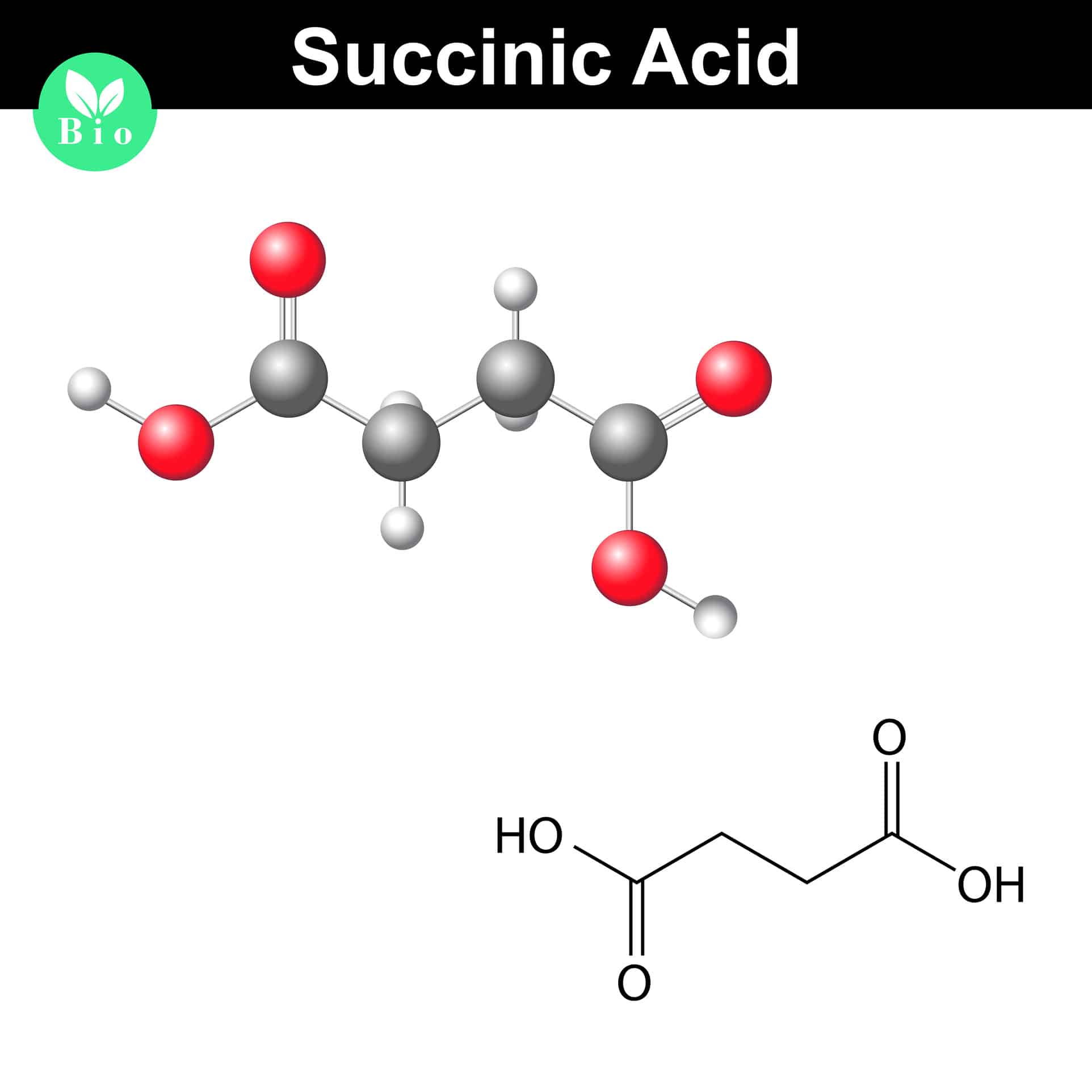Butanedioic Acid

Butanedioic acid, also known succinic acid, is a crystalline, colorless, aliphatic dicarboxylic acid that is a metabolic intermediate in both the citric acid cycle and the urea cycle. The formation of butanedioic acid is due to the oxidation of succinyl-CoA, which in turn results from the metabolic process of carbohydrates, fats, and proteins. Butanedioic acid can be further metabolized in the process to either generate energy or be converted into other compounds such as glucose or amino acids.
As can be seen from its name, succinic acid owes its name to amber, which is a so-called gemstone containing succinic acid. In addition to butanedioic acid occurring in the organism, the acid can also be found in nature. It is found in a variety of plant juices as well as in fungi and algae.
Butanedioic acid and its uses
Butanedioic acid is used in several areas. On the one hand, it is used as a food additive (E363) and, on the other hand, as a flavor enhancer for dishes such as desserts or dried soups due to its mildly sour and at the same time salty taste. It is also used as a solvent and plasticizer for plastics and waxes, and is also becoming increasingly popular in the cosmetics industry. Until deep into the 20th century, succinic acid was likewise utilized as a medicine, which was utilized to treat catarrh and syphilis.
Succinic acid in cosmetics
In the cosmetics and skin care industry, butanedioic acid is used as a natural ingredient in various products such as moisturizers, face creams and serums. Butanedioic acid is a natural compound that finds use in cosmetics as a humectant as well as moisturizer. A humectant describes a substance that helps retain moisture in the skin by absorbing water molecules from the air. This phenomenon is known as the hygroscopic effect and makes the skin’s appearance fresh and young.
Succinic acid also exhibits anti-inflammatory as well as antimicrobial properties, which makes it a useful ingredient in skin care products for people with inflammatory skin conditions such as eczema and especially acne conditions. In addition, some studies suggest that due to its support of cell renewal as well as its antioxidant effects, butanedioic acid can help soften fine lines and wrinkles. As a result, the face appears firmer and younger.
Butanedioic acid can also be used as a natural exfoliant as it helps remove dead skin cells. It is also used in hair care products to improve scalp and hair health. Butanedioic acid is considered a safe and effective ingredient in cosmetics and skin care products. People with sensitive skin can also rely on the raw material, as it is particularly well tolerated by the skin due to its endogenous production.
Fact Sheet: Butanedioic acid
INCI: Succinic Acid
CAS No.: 110 – 15 – 6
Other names: Succinic acid, E363
Molecular Formula: C4H6O4
Boiling point: 235 °C
Properties: exists as a colorless and odorless crystalline solid
We like to work with these raw materials containing succinic acid:
| Trade Name | Company Name | INCI | Comment |
|---|---|---|---|
| Vita Soft Peel | QUIMIVITA PRODUCTS SL | Succinic Acid | |
| Vita Cell Renova | QUIMIVITA PRODUCTS SL | Mandelic Acid, Succinic Acid, Tartaric Acid | |
| IceAwake | Mibelle AG Biochemistry | Succinic Acid, Maltodextrin, Aqua | |
| Vita Catiogel | QUIMIVITA PRODUCTS SL | Ceratonia Siliqua (Carob) Gum, Arginine, Succinic Acid | |
| CARNOXYN | Sharon Laboratories Ltd | Aqua, Carnitine Fumarate, Sodium Pyruvate, Succinic Acid, Citric Acid | |
| SHICONIX Liquid AB (N) | ICHIMARU PHARCOS CO., LTD. | Lithospermum Officinale Extract, Water, Butylene Glycol, Succinic Acid, Hydrolyzed Soy Protein, Aluminum Chloride | |
| Naturall-e d-Alpha Tocopheryl Succinate 1162IU | Matrix Life Science | Tocopheryl Succinate | |
| IMWITOR 780 K | Cremer Care | Isostearyl Diglyceryl Succinate |
High quality cosmetics with butanedioic acid from Cosmacon
Butanedioic acid as an organic acid is an attractive raw material due to its wide range of applications. It has benefits in the food context as well as in the technical and cosmetic fields. The cosmetics industry in particular has great expectations of succinic acid, as it is well tolerated due to its synthesis in the body and its special properties make it an extremely useful active ingredient in the field of anti-aging and acne-prone skin. Cosmacon will be happy to develop appropriate, high-quality formulations for you on request. Ask today for a non-binding consultation.
Sources:
An Overview of the Diagnosis and Management of Seborrheic Dermatitis.; Dall’Oglio F, Nasca MR, Gerbino C, Micali G. Clin Cosmet Investig Dermatol. 2022 Aug 6;15:1537-1548.
Butanedioic acid: Technology Development and Commercialization.; Nghiem NP, Kleff S, Schwegmann S. Fermentation. 2017; 3(2):26
Staphylococcus epidermidis in the human skin microbiome mediates fermentation to inhibit the growth of Propionibacterium acnes: implications of probiotics in acne vulgaris.; Wang Y, Kuo S, Shu M, Yu J, Huang S, Dai A, Two A, Gallo RL, Huang CM.Appl Microbiol Biotechnol. 2014 Jan;98(1):411-2